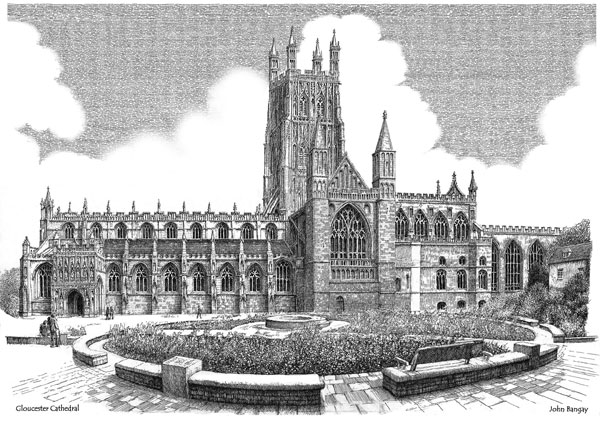Gloucester Cathedral

Founded in 679 by Prince Osric as a monastic community, little is known about its early history until it became a Benedictine house in about 1000. By the time of the Norman Conquest it was in serious decline with only two monks and a few boys and novices. Serlo, a monk from Mont St-Michel, was appointed Abbot in 1072 and, under his dedication and energy, the abbey grew rapidly in wealth and power. In 1089 he began constructing the great church we see today which was completed in less than fifty years, a remarkably short time for such an impressive building.
King Edward II died in mysterious circumstances at nearby Berkeley Castle and his body was brought to St Peter’s Abbey, Gloucester for burial in December 1327. Between 1331 and 1375 the quire and transepts were remodelled and the Great East Window installed. The south transept of 1331/7 is the earliest surviving example of the English Perpendicular style.
In the early 1400s the western bays of the nave and the SW porch were rebuilt under Abbot Morwent. In the 1450s Abbot Seabroke was responsible for building the 225ft high central tower on the existing Romanesque foundations and lower levels. The tower houses both the cathedral’s ring of twelve bells, two of which date from c1400, and Great Peter, the largest medieval bourdon bell still being regularly rung in England and weighing almost 3 tons. The Lady Chapel at the east end was built between about 1460 and 1482 and is a beautiful example of late English Perpendicular architecture.
In 1541 the abbey was reconstituted as Gloucester Cathedral, saved, no doubt, by the presence of the tomb of King Edward II. At the time of the Dissolution of the Monasteries under Henry VIII, many other monasteries without important royal connections were simply dissolved and their buildings left to fall into disrepair.
Recently a major programme of repairs and landscaping has been completed and the cathedral is now approached via spacious gardens and wide pathways.

